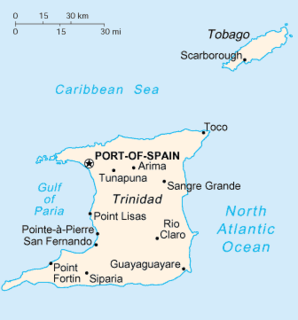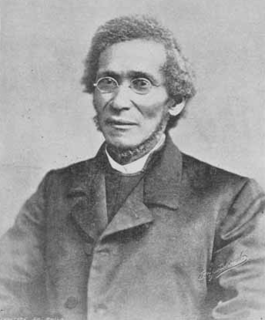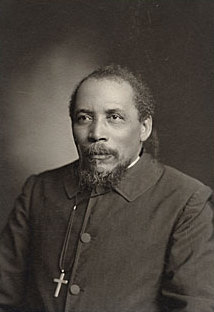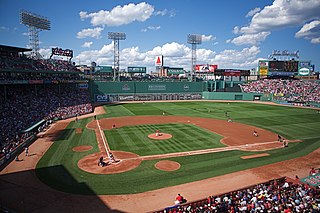
John Augustus Roebling was a German-born American civil engineer. He designed and built wire rope suspension bridges, in particular the Brooklyn Bridge, which has been designated as a National Historic Landmark and a National Historic Civil Engineering Landmark.

Richard Allen was a minister, educator, writer, and one of America's most active and influential black leaders. In 1794, he founded the African Methodist Episcopal Church (AME), the first independent black denomination in the United States. He opened his first AME church in 1794 in Philadelphia, Pennsylvania.

The African Methodist Episcopal Church, usually called the A.M.E. Church or AME, is a predominantly African-American Methodist denomination. It is the first independent Protestant denomination to be founded by black people. It was founded by the Rt. Rev. Richard Allen in Philadelphia, Pennsylvania, in 1816 from several black Methodist congregations in the mid-Atlantic area that wanted independence from white Methodists. It was among the first denominations in the United States to be founded on racial rather than theological distinctions and has persistently advocated for the civil and human rights of African Americans through social improvement, religious autonomy, and political engagement. Allen, a deacon in Methodist Episcopal Church, was consecrated its first bishop in 1816 by a conference of five churches from Philadelphia to Baltimore. The denomination then expanded west and south, particularly after the Civil War. By 1906, the AME had a membership of about 500,000, more than the combined total of the Colored Methodist Episcopal Church in America and the African Methodist Episcopal Zion Church, making it the largest major African-American Methodist denomination. The AME currently has 20 districts, each with its own bishop: 13 are based in the United States, mostly in the South, while seven are based in Africa. The global membership of the AME is around 2.5 million and it remains one of the largest Methodist denominations in the world.

Thomas De Witt Talmage was a preacher, clergyman and divine in the United States who held pastorates in the Reformed Church in America and Presbyterian Church. He was one of the most prominent religious leaders in the United States during the mid- to late-19th century, equaled as a pulpit orator perhaps only by Henry Ward Beecher. He also preached to crowds in England. During the 1860s and 70s, Talmage was a well-known reformer in New York City and was often involved in crusades against vice and crime.
The National Railway or National Air Line Railroad was a planned railroad between New York City and Washington, D.C. in the United States around 1870. Part of it was eventually built from New York to Philadelphia by the Delaware and Bound Brook Railroad and the Delaware River Branch of the North Pennsylvania Railroad, leased by the Philadelphia and Reading Railway in 1879 and becoming its New York Branch. The line was intended to provide an alternate to the various monopolies that existed along the route, specifically the United New Jersey Railroad and Canal Companies and their Camden and Amboy Railroad, and as such had a long struggle to be built.
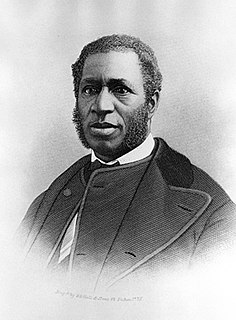
Richard Harvey Cain was a minister, abolitionist, and United States Representative from South Carolina from 1873–1875 and 1877-1879. After the Civil War, he was appointed by Bishop Daniel Payne as a missionary of the African Methodist Episcopal Church in South Carolina.
Bishop Frederick Douglas Washington was a Pentecostal minister of the Washington Temple Church of God in Christ (COGIC) in Brooklyn, New York. His most famous protege is Rev. Al Sharpton, whom acknowledged his call as a minister at the age of nine.
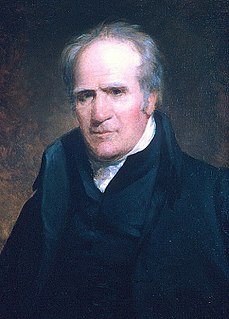
Robert Richford Roberts distinguished himself as an American Methodist Circuit Rider, Pastor, Presiding Elder, and Bishop of the Methodist Episcopal Church, elected in 1816. He was the first married man in America to serve as Bishop of the Methodist Episcopal Church.
Shepard Kollock, Jr. was an editor and printer, who was active in colonial New Jersey during the period of the American Revolutionary War. He also held various government positions in the newly founded state of New Jersey during the early 1800s.

Samuel Howard Woodson, Jr. was an American pastor, civil rights leader, and Democratic Party politician from New Jersey. He was the first African American to serve as Speaker of the New Jersey General Assembly.

Samuel Miller was a Presbyterian theologian who taught at Princeton Theological Seminary.

George Duffield was a leading eighteenth-century Presbyterian minister. He was born in Lancaster County, Province of Pennsylvania in 1732.

William B. Derrick was an African Methodist Episcopal (AME) bishop and missionary. He worked as a seaman early in his life and served in the Union Navy during the US Civil War. After the war, he joined the AME church and became involved in church leadership and missionary activities. He became a bishop of the church in 1896. He was also involved in Republican politics and civil rights.

John Bunyan Reeve was a Presbyterian minister and professor at Howard University. In 1871 he organized the department of theology at Howard.

Theodore Doughty Miller was a Baptist preacher from Philadelphia, Pennsylvania in the late 19th century. Before the US Civil War (1861-1865), he was a part of abolitionist society in Philadelphia, and after the war he played a leading role in the Baptist Church. In 1881 he was called "the best colored preacher ever located in Philadelphia".

Daniel Jones was a Methodist Episcopal minister (M.E.) in Oregon and later in the mid west. He was the first African American to attend Willamette University in Salem, Oregon. He was a leader in the M.E. church and was presiding elder of the Lexington, Kentucky district.
John Hudson Riddick was an educator, community leader, and minister in the African Methodist Episcopal (AME) church. In 1872 he was elected a member of the Norfolk, Virginia city council. He was an AME minister at a number of churches and a leader in the Washington and Delaware Conferences of the church.
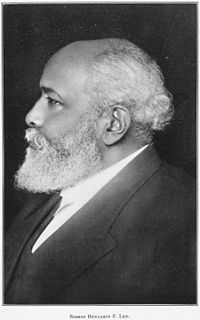
Benjamin F. Lee was a religious leader and educator in the United States. He was the president of Wilberforce University from 1876 to 1884. He was editor of the Christian Recorder from 1884 to 1892. He was then elected a bishop in the African Methodist Episcopal (AME) church, serving from 1892 until his resignation in 1921, becoming senior bishop in the church in 1915.



